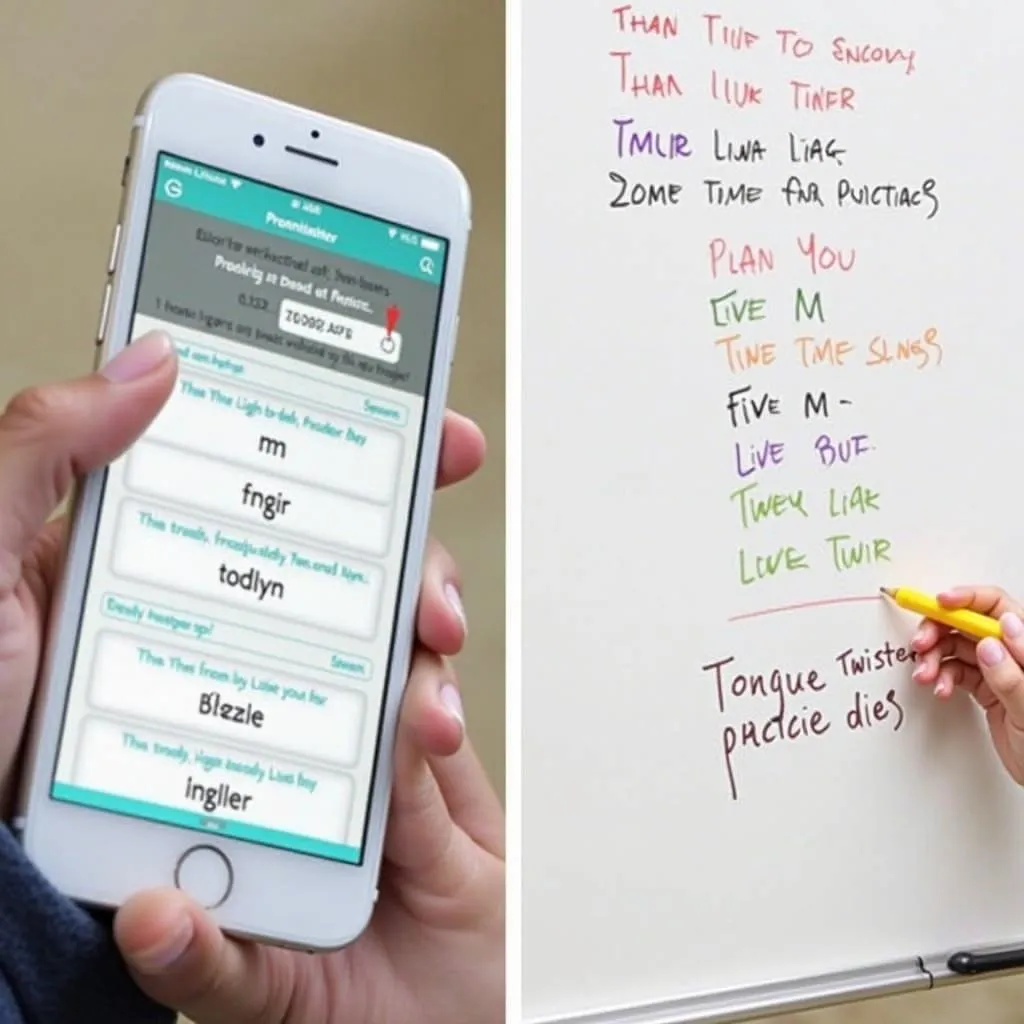Speaking confidently in English is crucial for success in the PTE Academic exam. While many test-takers focus on practice centers or language schools, you can significantly improve your speaking skills from the comfort of your own home. This article will guide you through effective strategies on How To Practice Speaking For PTE At Home, helping you boost your confidence and achieve your desired score.
How to build confidence for PTE exam is a key factor in your preparation journey. By implementing the right techniques and mindset, you can overcome anxiety and perform at your best during the test.
Creating an Ideal Home Practice Environment
Before diving into specific practice methods, it’s essential to set up a suitable environment that mimics the actual PTE exam conditions.
Minimizing Distractions
- Choose a quiet room with minimal background noise
- Inform family members or roommates about your practice schedule
- Turn off notifications on your devices
- Use noise-canceling headphones if necessary
Setting Up Your Practice Space
- Arrange a desk and chair similar to the exam setup
- Position your computer or laptop at eye level
- Ensure proper lighting to avoid eye strain
- Keep necessary materials (notepad, pencil, water) within reach
 Ideal PTE home practice setup
Ideal PTE home practice setup
Effective Strategies for PTE Speaking Practice at Home
Now that you have your practice space ready, let’s explore some powerful techniques to enhance your speaking skills for the PTE exam.
1. Utilize Official PTE Practice Materials
Start with authentic PTE resources to familiarize yourself with the exam format and question types.
- Use the official PTE Academic website for sample questions
- Invest in PTE preparation books with audio components
- Take advantage of free online PTE speaking practice tests
2. Record and Analyze Your Responses
Self-assessment is crucial for improvement. Follow these steps:
- Record your answers to PTE speaking tasks
- Listen to your recordings critically
- Identify areas for improvement (pronunciation, fluency, content)
- Compare your responses to sample answers
Dr. Emma Thompson, a renowned PTE coach, emphasizes the importance of self-recording: “Listening to your own voice may feel uncomfortable at first, but it’s one of the most effective ways to identify and correct speaking errors.”
3. Practice with a Virtual Study Partner
While practicing alone is beneficial, having a speaking partner can significantly enhance your skills.
- Join online PTE study groups or forums
- Use language exchange apps to find speaking partners
- Schedule regular video calls for mock speaking sessions
4. Focus on Pronunciation and Fluency
Clarity and smooth delivery are key components of the PTE speaking test scoring criteria. Improve these aspects by:
- Using pronunciation apps to perfect difficult sounds
- Practicing tongue twisters to enhance articulation
- Reading aloud to improve fluency and intonation
- Shadowing native English speakers in podcasts or videos
 PTE pronunciation practice techniques
PTE pronunciation practice techniques
5. Time Management Drills
Mastering time management is crucial for success in the PTE speaking section. Try these exercises:
- Set a timer for each speaking task
- Practice speaking concisely within the given time limits
- Use a stopwatch to monitor your response times
- Gradually decrease preparation time to improve quick thinking
6. Embrace Technology for Realistic Practice
Leverage technology to create a more authentic exam experience:
- Use PTE-specific practice apps with speech recognition
- Simulate exam conditions with background noise (e.g., typing sounds)
- Practice speaking while looking at a computer screen
- Utilize online voice recording tools for instant playback
7. Develop Content-Rich Responses
To score high on content, focus on:
- Building a diverse vocabulary related to common PTE topics
- Practicing storytelling techniques for describe image tasks
- Developing clear and logical structures for your responses
- Creating a personal bank of examples and anecdotes to use in various questions
Professor James Lee, an expert in language assessment, advises: “The key to high-scoring responses is not just fluency, but also the richness of your content. Prepare a toolkit of diverse ideas and examples to draw from during the exam.”
Overcoming Common Challenges in Home Practice
While practicing at home offers flexibility, it comes with its own set of challenges. Here’s how to address them:
Staying Motivated
- Set clear, achievable goals for each practice session
- Reward yourself for meeting milestones
- Track your progress to visualize improvements
- Join online PTE study communities for support and motivation
Dealing with Distractions
How to practice speaking under pressure for PTE is crucial for maintaining focus during the actual exam. Try these techniques:
- Practice with background noises to build concentration
- Use the Pomodoro technique for focused practice sessions
- Create a strict ‘do not disturb’ policy during practice times
Simulating Exam Pressure
To prepare for the stress of the actual test:
- Take full-length practice tests under timed conditions
- Practice speaking in front of a mirror to simulate an audience
- Record video of yourself answering questions to get used to being “observed”
- Engage in mock tests with online tutors or study partners
 PTE mock test simulation at home
PTE mock test simulation at home
Fine-Tuning Your PTE Speaking Skills
As you progress in your home practice, focus on refining these specific areas:
Mastering Re-tell Lecture
- Practice active listening and note-taking
- Develop a template for organizing your response
- Focus on capturing and rephrasing key points
- Use transition words to connect ideas smoothly
Perfecting Describe Image
- Analyze various types of images (graphs, maps, processes)
- Create a structure for describing different image types
- Practice identifying and describing key features quickly
- Use a range of descriptive vocabulary and comparative language
Enhancing Read Aloud Skills
- Work on clear pronunciation and natural intonation
- Practice chunking text for better pacing
- Focus on stress and rhythm in longer sentences
- Record and compare your reading with native speaker samples
Conclusion
Mastering how to practice speaking for PTE at home is a powerful way to prepare for the exam. By creating the right environment, utilizing effective strategies, and addressing common challenges, you can significantly improve your speaking skills and boost your confidence for test day.
Remember, consistent practice is key. Dedicate regular time to these techniques, and you’ll see substantial improvements in your PTE speaking performance. For more insights on optimizing your exam environment, check out these PTE exam room setup tips.
As you continue your preparation, consider taking PTE official mock tests to gauge your progress and familiarize yourself with the exact format of the exam. With dedication and the right approach, you’re well on your way to achieving your desired PTE score.
FAQ
How often should I practice speaking for PTE at home?
Aim for daily practice sessions of 30-60 minutes. Consistency is more important than long, infrequent sessions.
Can I improve my accent for the PTE speaking test?
Focus on clarity rather than accent. The PTE exam values intelligibility over a specific accent. Practice pronunciation of individual sounds and word stress.
How can I get feedback on my speaking if I’m practicing alone?
Use speech recognition software, record yourself and compare with sample answers, or join online PTE communities for peer feedback.
Is it necessary to use a headset microphone for home practice?
While not strictly necessary, using a headset microphone can help you get accustomed to the exam conditions and improve the quality of your recordings.
How can I expand my vocabulary for PTE speaking tasks?
Read widely on various topics, learn new words in context, and actively use them in your practice responses. Focus on academic and formal vocabulary.
What should I do if I feel stuck or don’t know what to say during practice?
Develop strategies like paraphrasing, using filler phrases, or drawing from personal experiences. Practice impromptu speaking on random topics to improve your ability to generate content quickly.